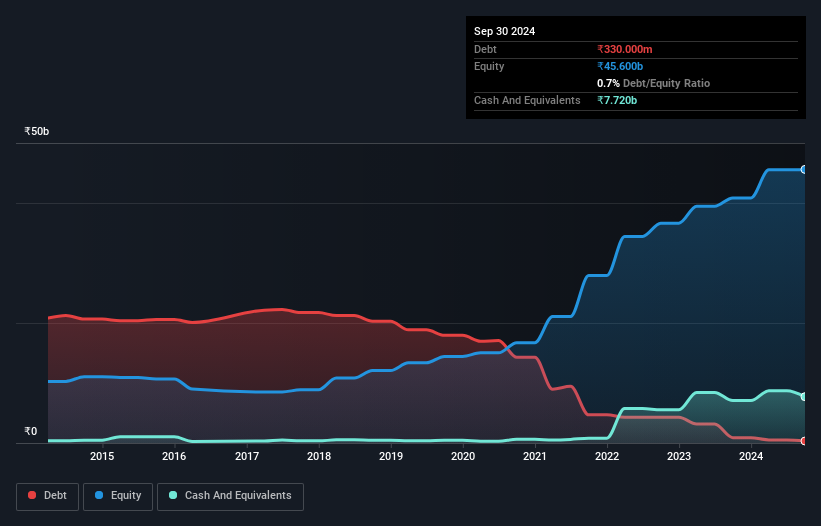The external fund manager backed by Berkshire Hathaway's Charlie Munger, Li Lu, makes no bones about it when he says 'The biggest investment risk is not the volatility of prices, but whether you will suffer a permanent loss of capital.' When we think about how risky a company is, we always like to look at its use of debt, since debt overload can lead to ruin. We can see that Godawari Power & Ispat Limited (NSE:GPIL) does use debt in its business. But is this debt a concern to shareholders?
When Is Debt A Problem?
Debt is a tool to help businesses grow, but if a business is incapable of paying off its lenders, then it exists at their mercy. Ultimately, if the company can't fulfill its legal obligations to repay debt, shareholders could walk away with nothing. While that is not too common, we often do see indebted companies permanently diluting shareholders because lenders force them to raise capital at a distressed price. Of course, the upside of debt is that it often represents cheap capital, especially when it replaces dilution in a company with the ability to reinvest at high rates of return. When we examine debt levels, we first consider both cash and debt levels, together.
View our latest analysis for Godawari Power & Ispat
How Much Debt Does Godawari Power & Ispat Carry?
The image below, which you can click on for greater detail, shows that Godawari Power & Ispat had debt of ₹330.0m at the end of September 2024, a reduction from ₹894.7m over a year. But it also has ₹7.72b in cash to offset that, meaning it has ₹7.39b net cash.

How Healthy Is Godawari Power & Ispat's Balance Sheet?
According to the last reported balance sheet, Godawari Power & Ispat had liabilities of ₹5.79b due within 12 months, and liabilities of ₹2.66b due beyond 12 months. On the other hand, it had cash of ₹7.72b and ₹2.78b worth of receivables due within a year. So it actually has ₹2.05b more liquid assets than total liabilities.
Having regard to Godawari Power & Ispat's size, it seems that its liquid assets are well balanced with its total liabilities. So while it's hard to imagine that the ₹122.4b company is struggling for cash, we still think it's worth monitoring its balance sheet. Succinctly put, Godawari Power & Ispat boasts net cash, so it's fair to say it does not have a heavy debt load!
Also good is that Godawari Power & Ispat grew its EBIT at 16% over the last year, further increasing its ability to manage debt. The balance sheet is clearly the area to focus on when you are analysing debt. But ultimately the future profitability of the business will decide if Godawari Power & Ispat can strengthen its balance sheet over time. So if you want to see what the professionals think, you might find this free report on analyst profit forecasts to be interesting.
Finally, a business needs free cash flow to pay off debt; accounting profits just don't cut it. Godawari Power & Ispat may have net cash on the balance sheet, but it is still interesting to look at how well the business converts its earnings before interest and tax (EBIT) to free cash flow, because that will influence both its need for, and its capacity to manage debt. Over the last three years, Godawari Power & Ispat reported free cash flow worth 16% of its EBIT, which is really quite low. For us, cash conversion that low sparks a little paranoia about is ability to extinguish debt.
Summing Up
While it is always sensible to investigate a company's debt, in this case Godawari Power & Ispat has ₹7.39b in net cash and a decent-looking balance sheet. And we liked the look of last year's 16% year-on-year EBIT growth. So we are not troubled with Godawari Power & Ispat's debt use. When analysing debt levels, the balance sheet is the obvious place to start. But ultimately, every company can contain risks that exist outside of the balance sheet. Case in point: We've spotted 1 warning sign for Godawari Power & Ispat you should be aware of.
At the end of the day, it's often better to focus on companies that are free from net debt. You can access our special list of such companies (all with a track record of profit growth). It's free.
New: Manage All Your Stock Portfolios in One Place
We've created the ultimate portfolio companion for stock investors, and it's free.
• Connect an unlimited number of Portfolios and see your total in one currency
• Be alerted to new Warning Signs or Risks via email or mobile
• Track the Fair Value of your stocks
Have feedback on this article? Concerned about the content? Get in touch with us directly. Alternatively, email editorial-team (at) simplywallst.com.
This article by Simply Wall St is general in nature. We provide commentary based on historical data and analyst forecasts only using an unbiased methodology and our articles are not intended to be financial advice. It does not constitute a recommendation to buy or sell any stock, and does not take account of your objectives, or your financial situation. We aim to bring you long-term focused analysis driven by fundamental data. Note that our analysis may not factor in the latest price-sensitive company announcements or qualitative material. Simply Wall St has no position in any stocks mentioned.
About NSEI:GPIL
Flawless balance sheet with reasonable growth potential and pays a dividend.
Similar Companies
Market Insights
Community Narratives




